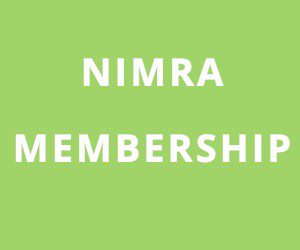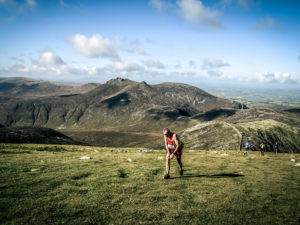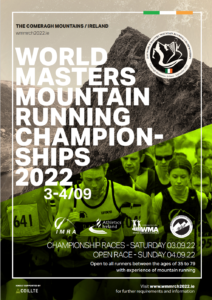What is mountain running?
Mountain running, sometimes known as hill running or fell running, is a sport which takes place mainly off-road. Within Northern Ireland, mountain running is a particularly popular sport within the Mourne Mountains, the Sperrin Mountains and the Glens of Antrim.
In terms of mountain races, there can be a great variety of distances, climbs and types of terrain. Races can be a couple of kilometres up to several hundred kilometres. A race might climb just one mountain or a whole range, with race details giving you the total amount of climb involved. The climb might be gradual or steep, involving use of hands. Underfoot it might be a wide track, a rocky path, a boggy trail or there might not be any defined way through heather or undergrowth. Sometimes the race organisers tell you the route to follow, and at other times it is up to you to figure out the fast way between points.
What’s the best way to get into mountain running?
The best place to start is to join an athletics club that participates in mountain running. These clubs are found throughout Northern Ireland, particularly around areas where there are hills and mountains. Try and find one local to you so that you can join them for training sessions. Athletic clubs that participate in NIMRA events include:
- Newcastle & District
- Mourne Runners
- Belfast Association of Rock Climbers and Fell Runners (BARF)
- Dromore AC
- Orangegrove AC
- Glens Runners
- Scrabo Striders
- North Belfast Harriers
- East Antrim Harriers
- Newry AC
- Jog Lisburn Running Club
- Ballydrain Harriers
- Larne AC
- Springwell Running Club
- Blayney Rockets AC
You do not have to be a member of an athletics club to participate in a NIMRA event, but some people really appreciate joining such clubs so that they can learn from other mountain runners more about the sport and the many skills involved.
What is the first mountain-running race I should do?
The best place to start is the Hill and Dale Series. It is a series of ten races held from April to June every year, normally taking place on Thursday evenings. Newcastle & District AC organises the series.
The Hill and Dale Series takes place in and around the Mourne Mountains, starting off on gentle forest tracks like in Castlewellan and Tollymore Forest Parks before going on to more rugged and steeper terrain. Races vary in length but are normally a maximum of 5 miles (8 kilometres) with 2,000 feet (600 metres) of climb.
Note that some of the Hill and Dale Series races are on marked courses, with flags or marshalls along the route. Some, however, are not marked and navigational skills are required (see below).
When will I be ready for NIMRA races?
The NIMRA championship consists of nine races held throughout the year. They typically take place on weekends. These races are organised by some of the athletics clubs mentioned above under the NIMRA umbrella. Three races in the series are short, three races are medium, three races are long.
Short: Distance up to 6km, Climb up to 400m
Medium: Distance of 6km-20km, Climb of 400m-1500m
Long: Distance over 20km,climb over 1500m
Some of these race routes are marked, some of not. Some take place on highly frequented routes with many hikers along the way. Some of the races are on remote and isolated mountains where navigation and self-sufficiency is key.
Whereas a Hill and Dale Series race may attract several hundred people for a race, a NIMRA race can have as few as fifty. This means that runners can easily get spread out on a NIMRA event, and you may end up running alone through the mountains for certain sections, particular if the mist is down and visibility is poor. Because of this, it is probably wise for a beginning mountain runner to have been running in the hills for a least a year before entering a medium or long NIMRA event.
What kit do I need to bring on a race?
The most important kit you need on a mountain race are shoes with good grip. Normal road running shoes are not suitable for running down steep, slippery terrain as they are too smooth underfoot. Popular brands include Inov-8, Salomon, Walshes, Asics, Hoka and Altra, but do ask other mountain runners what they recommend as models change as materials improve.
In terms of mandatory kit, you must bring to all races the following:
- Waterproof jacket with attached hood and taped seams.
- Footwear suited to the race terrain
- Waterproof trousers.
- Hat & gloves
- Foil Blanket.
- Emergency food & drink- a gel or bar is sufficient.
This kit is checked at the race start, so if you fail to bring it, you will not be allowed to race. This kit is to ensure your safety and may indeed save your life if you have an accident on the course. In shorter races the race organizer may decide that not all kit needs to be carried but you should come preprared to have it with you on the event.
For waterproof jackets and trousers, popular brands include Montane, Salomon, Inov-8 and Columbia. If you join an athletics club, you can always ask other mountain runners what they recommend.
Do I need to use a map and compass to participate?
A map and compass are mandatory kit on NIMRA races and you should be able to use them. Some races allow you to use GPS, but some (such as the Annalong Horseshoe) ban GPS usage.
Many people learn how to map read and use a compass by being out with other competent navigators on the mountains and learning directly from them. Alternatively you can book a course with a private provider such as Happy Out Adventures that runs mountain-running navigation courses. Some of the best navigators go orienteering and there are events organised throughout the year.
Mountain Running safety basics
Mountain running is a fun, exciting sport, but it comes with its own set of risks. Please remember:
- Runners are primarily responsible for their own safety and take part in Mountain Races at their own risk.
- Runners must be aware that mountain races are run over rough, uneven, and slippery terrain, may involve steep ascents and descents, and routes can be in close proximity to cliffs.
- Runners must be members of NIMRA to score points in Championship races but do not need to be a member to participate in events.
- Runners must be aware that descending runners always have right of way.
- Runners must be aware that weather conditions at the start of a race are no guarantee of the conditions later on in the race, or at a different point on the race route. A clear mountain at the start of a race can be covered in mist with visibility down to five metres within a short time.
- Not all race routes will be marked. If the route is not marked, runners must have navigational skills and familiarity with a map and compass.
- All runners must report to the finish marshalwhether they complete the full race route or not. If you do not cross the finish line at the end of a race you must confirm that you are safe with the finish marshal or any race official. Do not leave a race location before confirming that you are safe.
- The organisers reserve the right to refuse an entry in a race to any individual.



